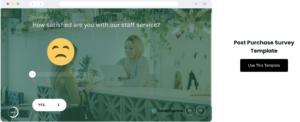Survey & Feedback
How to Create an Effective Survey: 10 Survey Best Practices
Article written by Kate Williams
Product Marketing Manager at SurveySparrow
20 min read
19 September 2025

Getting less-than-desirable results with your surveys? Are you looking for some actionable survey best practices and tips to get the best out of your surveys?
Surveys are a great tool to get feedback (or insights) directly from your audience.
But you need to follow a set of practices to put this tool to good use and get useful feedback from your target audience.
In this article, we share 10 survey best practices that will nudge your respondents to take your survey and give you accurate answers.
10 Survey Best Practices You Should Follow to Get Great Results with Your Surveys
Whatever your purpose for creating a survey is, there are several tips and tricks that you can use to make them a success. Brush up your basics of survey science with our effective guide down below-
- Keeping your surveys short and simple
- Asking one question at a time
- Seizing the day with mobile-first surveys
- Avoiding biased questions
- Limiting open-ended questions
- Avoiding unnecessary questions
- Testing your survey before sending them out
- Adding fun to your survey
- Using incentives for that extra nudge
- Using visual aids to clarify
Survey best practice #1: Keep your surveys short and simple
One of the biggest reasons you see high survey drop-offs is that you expect a lot from your respondents. If you hope they will complete your surveys with more than 50 questions, you are in for a shock. Many will think, “The nerve they had in expecting us to spend so much time on their survey.” Trust us, you certainly do not want that. It will also take a hit on your reputation.
So, how to write a survey?
The most basic thing you can do for successful surveys is keep them as short as possible. Remember that your respondents are not obligated to complete the survey. If anything, they only do you a favor by completing the survey. When you design the survey, please keep in mind that it should capture their attention and keep it that way until the survey ends.
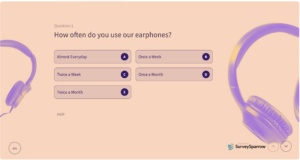
If you keep confusing the respondents of your survey by asking questions that are not in a logical order, you will certainly see a rise in drop-offs. The questions you draft should make a lot of sense to your audience and be relevant to them too.
Even a 10-minute long survey can be a huge ask for most respondents. If you provide them incentives to complete the survey, then time shouldn’t be an issue for most of them. When there is no incentive for the respondent when they complete the survey, why would they spend a lot of their time for you? This is exactly why you need to keep it short and simple.
No matter what type of surveys they are, customer satisfaction surveys best practices, employee survey best practices, NPS survey best practices, or exit survey best practices, keeping it simple and short is the most basic survey design best practice you should follow.
Survey best practice #2: Ask one question at a time
One more big mistake that most businesses make is they try to squeeze more than one question. It will completely confuse the answer; more often than not, even the options you provide might not make sense. Choosing to ask just one question is an important thing to remember in your survey design best practices.
Let’s make you understand with an example.
“How satisfied are you with the customer support team and the onboarding process?”

If the answer to both questions is the same, then there is no problem. Either they are “Extremely disappointed” or “extremely satisfied” with customer support and the onboarding process. How would a respondent reply if they had a bad experience with the support team, but the onboarding process was fantastic? There’s no way to get it right when there are two questions, right?
The above type of question is also called the double-barrelled question, which is certainly not welcome in a survey. People will skip questions that are confusing them. Or worse, they might even leave the survey. The easiest way to fix this issue is by concentrating on just one option and creating a separate question for the other option.
Survey best practice #3: Mobile-first surveys
Take advantage of scripting tools that will intelligently capture the layout of the content based on the question being presented, screen size, and the device being used. When you use intelligent layouts, it tries to fit the device on a smaller screen. It provides a great experience for the user where they can respond to the survey by watching it at the right size.
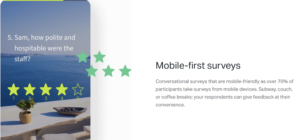
Designing for mobile devices is not only about fitting the questions on the screen but also about providing a great experience for the respondent. The respondents should have a great experience where they do not find any friction during the process.
Note: If you’re looking to enjoy uninterrupted, seamless feedback collection, SurveySparrow’s mobile-first surveys are the way to go. With an emphasis on conversational surveys that get you a 40% increased response rate, you can get started immediately by signing up. (completely free, of course)
14-day free trial • Cancel Anytime • No Credit Card Required • No Strings Attached
Survey best practice #4: Avoid biased questions
Sometimes, some of the survey questions are designed in such a way that there is bias in the questions or you might even be persuading the respondent to choose a particular option. To avoid errors such biased questions, ensure you only give as much information as necessary for the respondent.
Ensure that the question only focuses on the respondent’s opinions and the objectives you intend to achieve organically. Do not introduce words in the question which can be counted as your point of view.
For example:
- “Did you enjoy our fantastic email marketing tool?”
- “Are you satisfied with our exceptional customer service?”
- Adding words like fantastic and exceptional to your questions will only make them feel as if they are being led on.
- Instead of framing the above two questions in that style, here’s what you can do:
- “Did you enjoy our email marketing tool?”
- “Are you satisfied with our customer service?”
The above questions will get you the right answers from your respondents, and you do not have to worry about being biased. It is considered one of the most pivotal best practices for surveys.
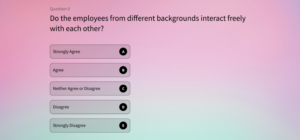
Survey best practice #5: Ask limited open-ended questions
First things first, open-ended questions are great for the audience as they allow them to share what they feel without a bunch of options limiting them. Do remember that answering an open-ended question might not be something that makes a lot of your respondents comfortable. It is best that you limit the open-ended questions to one or two. Anything more than that can be a lot to expect from your respondents.
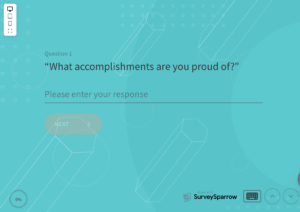
One more thing that you should do is to add these open-ended questions at the end of the survey. If you add them right in the beginning, it can put off many people. You can even add clear instructions on the kind of answer you are expecting from them.
Also, open-ended questions are not great to answer on mobile phones, thanks to the screen size and the keyboards. Do not ask two open-ended questions on the trot. Make sure that you only add them if it is really necessary. Too many of them can result in survey fatigue. You do not want that.
Know more: Guide to Asking Open-Ended Questions + Examples
Survey best practice #6: Do not ask unnecessary questions
One of the most important survey best practices that you have to keep in mind is to only ask absolutely necessary questions. When there are a lot of questions, it can also lead to survey fatigue. Once you are ready with the initial set of questions for your survey, the next thing that you need to do is trim down the ones that are not pivotal for the success of your survey.
You might even come across questions similar to something previously asked in the same survey. Ensure that all the stakeholders are involved when the survey questions are being made.
The questions that you ask should be straightforward and keep them engaged. If there are potentially sensitive questions that you have to ask, provide the respondents the opportunity to respond to the entire survey anonymously. Also, make sure not to put such sensitive questions at the beginning of the survey.
Survey best practice #7: Test your survey
Once you have created the questions, you will be ready to send them to your audience. Wait. Do not. At least not yet. If you want to make sure that your survey does not have any hiccups, test it. Please send it to different stakeholders in your organization. Ask them what they think about the questions. What do they think about the order in which these questions are asked? Let them know about the kind of audience that you will be sending the survey links to.
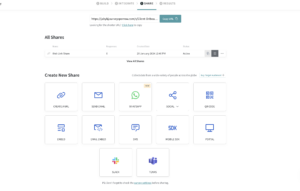
Perspectives from different people in the organization can be used to enhance the survey’s effectiveness. By testing your survey, you can catch all the possible errors. You will also be able to understand if any design issues affect the respondents’ experience.
Noticing a spelling mistake or a typo can be disastrous for an organization. It is best to avoid it by scrutinizing every letter that has been added to the survey.
Imagine if you were to send a survey questionnaire with many mistakes; it would deeply affect your credibility as an organization. Preview the survey and send it only when it has gone through many eyes already.
Survey best practice #8: Make the survey fun
It would be best if you connected with your audience with the help of the questions you ask. Make the survey as easy as possible for your respondents. Use light-hearted humor in your questions.
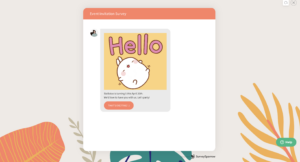
Even memes are a great addition to your surveys. Making it fun is a part of survey best practices that you should be mindful of. It will increase your output as you give them the opportunity to have fun while completing the survey. One more way to make sure the survey is not monotonous is to use different types of questions, including scales.
Survey best practice #9: Use incentives
We cannot insist on the importance of providing incentives to your survey respondents. While you cannot provide incentives for all surveys, you can still use them for ones that either take up a lot of time to complete or require specific technical know-how to be a participant.
In both the previous cases, you will certainly increase the response rates by providing incentives to your survey participants. People like the idea of spending a few minutes on a survey to get something back. They do not want to waste a significant amount of time.
Make sure that you find an appropriate survey incentive. If you are dealing with high-net-worth individuals, offering them a $10 coupon will not work. Do not provide incentives that are too big as you might not be able to repeat it later on and this can lead to disappointment as the respondents might be looking forward to the same incentives the second time they are asked to participate in a survey.
Survey design best practice #10: Use visual aids to clarify
There will be instances when the question might sound too complicated for the respondents. If you do not explain what you are trying to ask, they might skip the question, or worse, they might skip the survey itself. In cases such as this, it is best that you add visual aids such as audio and videos to explain your stance clearly. Ensure your survey design is visually appealing and appropriate to provide better visual support.
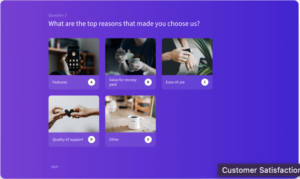
Let’s say you want feedback on the latest product from your brand, and it can get a little too complicated to explain it with just words. At this juncture, using audio and videos will ease the situation for your respondents. Instead of adding a few paragraphs to explain the question, visual aids will give a better idea of your target market.
There will be times when you might have to ask questions that might be considered personal, and you need to explain to your participants the relevance of these questions for your brand. Do add how you intend to use the information that they provide.
Bonus
We would hate to miss out on telling you the importance of using the rating scale wisely. When it comes to survey rating scale best practices, it is best that you use similar rating scales. If you use a 7-point Likert scale, use them uniformly across the survey. Introducing a 5-point Likert scale in between can confuse the average respondent. It is best to consider this a survey best practice to follow without fail. Do remember that the process of taking surveys should be as friction-free as possible. Keeping it easy for the respondents is the first step toward doing that.
How to Distribute a Survey Seamlessly
After designing the survey, the next step is to send it to your survey respondents. There are certain survey best practices that you have to follow even when it comes to the distribution of the same.
- Give Advance Notice: Start talking about the survey at least two weeks before sending it so people expect it.
- Be Transparent About Time: Clearly inform respondents about the survey’s expected time commitment.
- Assure Data Safety: Ensure respondents know their data is safe and explain the survey’s purpose, especially if it includes personal questions.
(For example, SurveySparrow is GDPR-compliant and ensures customer data is safe and secure.)
- Send Reminders Wisely: Send three reminders over ten days, not on consecutive days, to boost survey participation.
- Act on Feedback: Don’t let survey input go to waste; take action on feedback from respondents.
- Show Gratitude: Thank survey participants for their time to build a positive relationship for future surveys.
How do you design a survey questionnaire of your needs?
If you’re looking for an efficient and user-friendly survey creation tool, SurveySparrow is the perfect choice. It simplifies the survey design process and offers over 1000 premade templates that you can easily select and customize to suit your needs.
SurveySparrow’s intuitive interface allows you to create engaging and personalized surveys with various question types and logic options. You can distribute surveys through email, websites, or links, and it even supports conversational surveys for higher response rates.
With real-time analytics and reporting tools, SurveySparrow helps you extract valuable insights from your survey data, making it the ultimate solution for gathering feedback and making informed decisions. Save time and create effective surveys with SurveySparrow.
Use this survey questionnaire template for free
14-day free trial • Cancel Anytime • No Credit Card Required • No Strings Attached
How to Create a Survey Using SurveySparrow?
To create or design a survey questionnaire using SurveySparrow, follow these steps:
- Sign up or log in to your SurveySparrow account.
- Click on “Create Survey” to start a new survey project.
- Choose a survey template from SurveySparrow’s library or start from scratch.
- Customize the survey by adding, editing, or deleting questions as needed. You can use various question types, including multiple-choice, rating scales, and open-ended questions.
- Organize and sequence the questions logically to create a flow within the questionnaire.
- Use SurveySparrow’s design features to make your survey visually appealing by adding branding elements, colors, and images.
- Set up skip logic and branching to create a personalized survey experience for respondents.
- Configure survey distribution options, including email invitations, website embedding, or sharing links.
- Test your survey to ensure it functions correctly and looks good on various devices.
- Once satisfied, launch the survey and collect responses.
- Monitor real-time results and analyze data using SurveySparrow’s analytics and reporting features.
- Generate insightful reports and share them with your team or stakeholders.
SurveySparrow’s user-friendly interface and features simplify the process of designing, distributing, and analyzing surveys, making it a valuable tool for efficient data collection and decision-making.

Sign up with your email for free and start exploring SurveySparrow today.
A personalized walkthrough by our experts. No strings attached!
How to Get Better Survey Responses?
To get survey responses effectively, follow these strategies:
- Clear Communication: Communicate the purpose and importance of the survey to potential respondents.
- Targeted Audience: Ensure your survey reaches the right audience who have a vested interest in the topic.
- Personalized Invitations: Send personalized invitations with a compelling subject line and explanation of why their input matters.
- Timing Matters: Consider the timing of your survey – send it when your audience is most likely to engage.
- Multiple Channels: Use various distribution channels such as email, social media, websites, and in-person methods.
- Incentives: Offer incentives like discounts, gift cards, or entry into a prize draw to motivate participation.
- Mobile Optimization: Make sure your survey is mobile-friendly, as many people prefer taking surveys on their smartphones.
- Follow-Up: Send reminder emails or messages to non-respondents to increase participation.
- Engaging Design: Create an engaging survey with a user-friendly interface and visually appealing elements.
- Short and Focused: Keep the survey concise and focused to prevent respondent fatigue.
- Privacy Assurance: Assure respondents that their data will be kept confidential and anonymous.
- Feedback Loop: Provide a way for respondents to offer feedback or ask questions about the survey.
How to Analyze a Survey Response?
Analyzing a survey involves several key steps. First, clean and organize your data, checking for errors or missing responses. Next, summarize your data using descriptive statistics like averages or percentages to gain an overview. Identify trends or patterns by segmenting data based on demographics or other relevant factors.
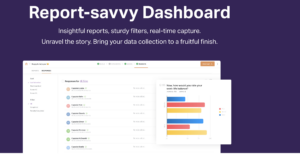
Then, use statistical tools for more in-depth analysis, such as regression analysis or hypothesis testing, to draw meaningful conclusions. Finally, visualize your findings through graphs and charts to make the results easily understandable for decision-making.
Conclusion
The goal of creating a survey is to find out what the respondents have gone through or how they want things changed. You cannot afford to only have a small sample size to respond to them. For your results to be considered correct and worthy of putting in time and effort, you need to have a sizable set of people respond to them. Some of the above tips will help you in getting the results that you want to achieve with your survey. Go out of your way to create fantastic survey questions, and you will be able to achieve it.
If you are looking for an online survey tool to take care of your survey needs, SurveySparrow is a choice that you will not regret making. It is one of the best tools in the market and has a variety of features, from its conditional branching feature to anonymous survey capability; you can do so much with it.
Frequently Asked Questions(FAQ’s)
- How to write a survey?
- Clarify survey objectives.
- Create clear, unbiased questions.
- Mix question types effectively.
- Keep it concise and visually appealing.
- Analyze results for valuable insights.
2. How to design a Survey?
To design a survey effectively, start by defining your survey’s purpose and objectives. Identify your target audience and create clear, unbiased questions using different question types. Organize questions logically, keeping the survey concise and visually appealing. Test it with a small group, adjust based on feedback, and ensure respondent privacy and anonymity. Provide clear instructions, and after data collection, analyze the results to extract meaningful insights.
3. How to create survey questions?
- Define objectives.
- Choose question types.
- Keep questions clear and concise.
- Avoid bias or leading language.
- Order questions logically.
- Test and refine as needed.

Create engaging surveys that people actually complete. Try SurveySparrow now!
Kate Williams
Excels in empowering visionary companies through storytelling and strategic go-to-market planning. With extensive experience in product marketing and customer experience management, she is an accomplished author, podcast host, and mentor, sharing her expertise across diverse platforms and audiences.
Related Articles

Survey & Feedback
Survey Bias with Examples: How To Stop Them From Creeping Into Your Survey
16 MINUTES
26 July 2022

Survey & Feedback
How To Measure Customer Feedback With Semantic Differential Scale: The Complete Guide
10 MINUTES
23 February 2021

Survey & Feedback
Sampling Bias: Definition, Types, and Tips on How To Avoid It
10 MINUTES
9 January 2023
![15 Types of Surveys: Complete Guide with Examples & Best Practices [2026] Different types of survey methods](/_next/image/?url=https%3A%2F%2Fstatic.surveysparrow.com%2Fsite%2Fstrapi-content%2Fuploads%2F2024%2F10%2Fsmall_Different_types_of_survey_methods_046878bca8.png&w=3840&q=75)
Survey & Feedback
15 Types of Surveys: Complete Guide with Examples & Best Practices [2026]
20 MINUTES
19 July 2021

